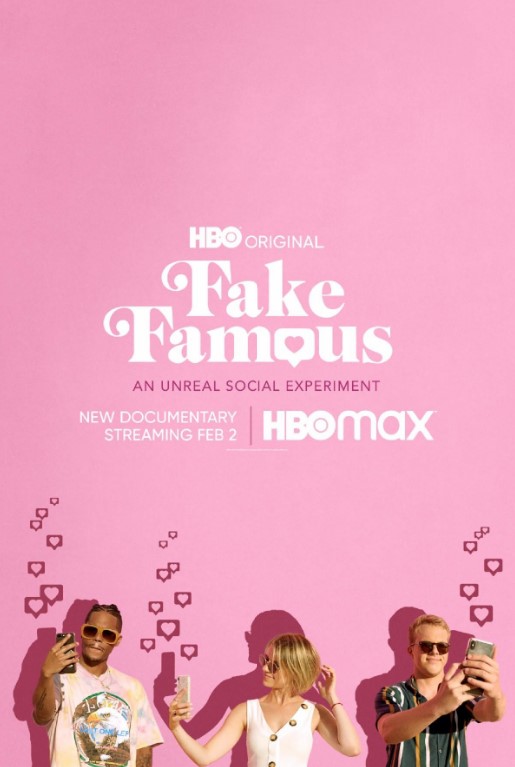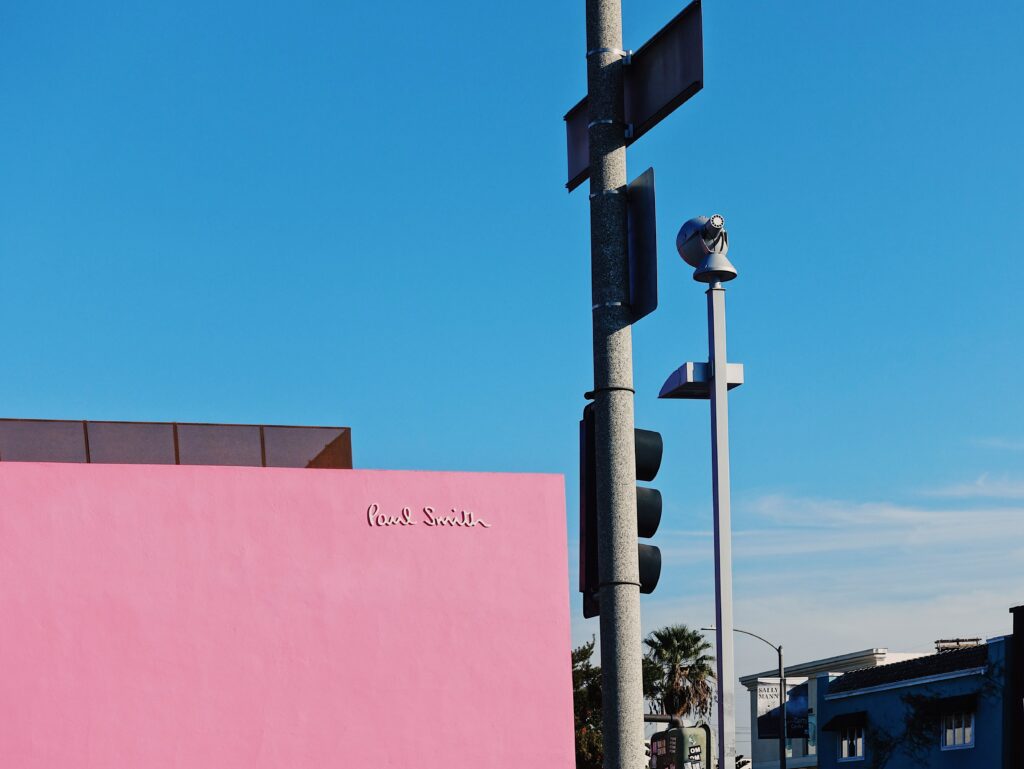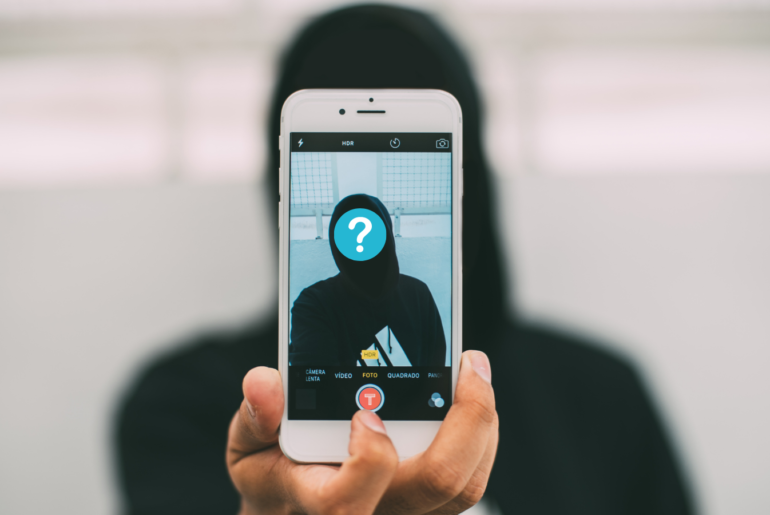What makes an Influencer? When more than 100 million people have over 100,000 followers, who among them are truly famous? These are questions asked in the 2021 documentary Fake Famous, streaming on HBO. The film is clearly focused on evoking a strong reaction from the audience, but marketers can read between the lines to get a better understanding of the preconceived opinions and views of influencers as a marketing strategy.

Fake Famous is the brainchild of journalist Nick Bilton, known for his books Hatching Twitter and American Kingpin, focused on the founding of Twitter and the masterminds behind the Silk Road darkweb site respectively. The filmmaker put out a casting call, asking for anyone who wants to “be famous”, and quickly finds three L.A.-based twentysomethings who aspire to the influencer lifestyle.
The Pink Wall

The documentary opens on a pink wall. This is not any wall, but the “iconic” pink selfie wall at the intersection of Melrose and Harper; the western exterior of designer Paul Smith’s flagship store in Los Angeles. This is a destination for the social savvy, particularly during the Golden Hour when the long shadows and rich sunlight create the perfect ambiance for a photo.
The voiceover dramatically talks about how the vast majority of kids would rather be an Influencer rather than a doctor or police officer. This is a twisting of statistics, many kids are interested in specifically being a vlogger on Youtube, not an influencer in the commonly understood social media sense.
The film continues to introduce the three individuals who will be made Insta-famous over the course of this “social experiment”.
This initial shot sets up a tone that influencers are narcissists obsessed with getting free stuff.
It should be noted that there has been pushback against the film with some calling it misogynistic and many being turned off by the condescending tone. The filmmaker attempts to temper the disdain with the inclusion of narratives from digital content experts who have helped create influencer marketing as we know it. Though for many, me included, it still feels like sour grapes.
Do you want to be Famous?
People have greatly varied reasons to be Insta-Famous. As a marketer, one of the most interesting parts of the film was listening to the reasons people want to be Influencers and their definition of a “real” influencer. Some of my favorites are below:
- People want a platform.
- They want to share a message.
- They want to connect.
- An influencer is half-entrepreneur and half-celebrity.
- An influencer is someone who has a lot of followers.
- Someone who has access to a large following and able to promote themselves and promote brands.
- It is about presenting a lifestyle that people want to mimic.
- Removal of gatekeeping that previously kept mass media in the hands of the wealthy or corporate.
Overall, the documentary associates being an Influencer with being famous. Influencing is an opportunity to develop the celebrity lifestyle without necessarily having to do the acting, performing, or otherwise excelling that people must do to achieve celebrity status.
Justine Bateman, author of Fame: The Hijacking of Reality, sums it up, “The desire to be famous is the desire to be loved. As media expanded, it opened a lot more avenues for fame…” and for people to become famous.
Bad Influencer Tactics
The pathway to fame for these three aspiring influencers is paved with the most inauthentic and unethical practices that have created ongoing mistrust towards the Influencer community.
First, they start by buying followers. 7500 followers for $119.60, delivered slowly over three days to it won’t trigger suspicious activity alerts with Instagram.
Marketers know that fake followers not only mess up data and ruin actionable insights, but they are also dangerous to the organization. In 2019, the FTC started enforcement cases against Influencers and those continue to this day. One defendant was fined over 2.5 million dollars and was required to maintain extensive compliance recordkeeping for the next 10 years.
Recent studies show that only 14% of influencers are fully compliant with the Federal Trade Commission and its U.K. equivalent, the Competition and Markets Authority.
You can read more about FTC Influencer Guidelines and the aforementioned case here.
Then came the staged photo shoots. Marketers are used to edging around the truth with photoshoots. That’s why user-generated content is so incredibly valuable. People trust other people, not overly curated photography. But these “Influencers” go beyond ring lights and selfie sticks. Their photoshoots are elaborate productions with beauty teams, professional lighting, and staging that would make any brand jealous.

Fake Influencer Scenes to keep an eye out for:
- Using butter and cocoa powder to fake chocolate that’ll hold up under the lights
- Renting a home to fake a vacation photo shoot, then tagging high-end hotels on social media
- Filling up a dirty kiddie pool with water and flower petals to fake a spa day
- Using a toilet seat to fake an airplane trip
- Renting a private jet movie set
Another great “Influencer Staging” case study was created by Natalia Tayor, who faked an entire vacation to Bali by having a photoshoot in an Ikea.
Then Came the PR Boxes
Not long after the photoshoots and purchased followers, the aspiring influencers started receiving brand offers. It started small, one was offered a few pairs of sunglasses in exchange for some posts. Another was offered access to a private gym in exchange for content. Then the bigger PR boxes started arriving.
Things get crazy with one of the participants receiving a DM calling out his fake followers and another deciding to delete all the fake comments in order to find their own authenticity. You’ll need to watch the documentary for the rest.
4Takeaways for Marketers
1. Caveat emptor
Buyer Beware! As with all marketing channels, do your research before you begin. There are tools that can help detect fake followers, but -as shown in the film- they can be tricked too. If you decide that influencer marketing is for you then do your homework, ask for references, deploying technology to help manage the tracking, and considering contracting with a reputable influencer agency.
2. Clearly understand the difference between Influencers and Content Creators
Content creators are influencers, and Influencers create content, but they are not the same things, except when they are. Confused yet?
eMarketer does a great job explaining that the circles of “Influencer” and “Creator” are a Venn Diagram where some things overlap and there are still nuances of difference. Creators of different types drive different engagement on different platforms. Influencers often aspire to celebrity but many are also creators to some degree. This nebulous concept can be distilled into two bullets:
- Creators are people who develop content for digital properties and who consider that content to be the core of their career or livelihood.
- Influencers sway brand preference and loyalty of a population because of their notoriety, lifestyle, or fame.
A small creator, with devoted followers who are interested in their niche content, will drive more action than a similarly sized lifestyle influencer. These micro-influencers see 7x the engagement (by ratio) over mega-influencers and that number is even higher on TikTok.
Focus on building authentic influencer relationships with digital contributors and seek out newer social media personalities that have an affinity with your brand and your audience. The connection will be much more sincere and authentic.
Digital natives have a sixth sense to find inauthentic content, don’t trigger it.
3. People are still stuck on vanity metrics.
The film’s director and his team continually focus on likes and comments as their primary metrics. Marketers have known for years that vanity metrics can be greatly skewed and are detrimental to understanding the true ROI of specific channels. Engagement is more than empty likes and vapid comments. Social marketers are looking for brand mentions, clickthroughs, swipes, and more.
As Social Commerce continues to boom, marketers are also looking at metrics that outline the buyer’s journey. Shoppable social and shoppable livestreams mean that direct conversion metrics are also now being tracked by social media teams.
With Instagram starting to hide likes maybe more nonmarketers will understand that likes and follower counts are not the end-all for social metrics.
4. Strengthens the case for micro-influencers
This film feels like a parable in support of micro-influencers. There is great possibility and also great perils associated with Influencer campaigns. Mega-influencers are expensive and even big creators are one round of Twitter drama away from being canceled.
Micro- and nano-influencers are the tastemakers and social butterflies that cultivate a deep connection with their networks. They may not have the singular reach of a mega-influencer but activated in tandem with other similar contributors, their aggregate results are amazing.
That’s why 75% of marketers are currently, or planning to, work with micro-influencers and there has been a 300% increase in the number of micro-influencers used by companies since 2016. More so, 47% of marketers will spend their influencer budgets on micro-influencers instead of mega-influencers this year.
—
Did you enjoy the movie? Have thoughts? Excited to start marketing with micro-influencers? Our solutions experts are ready to help. Schedule a chat today.



